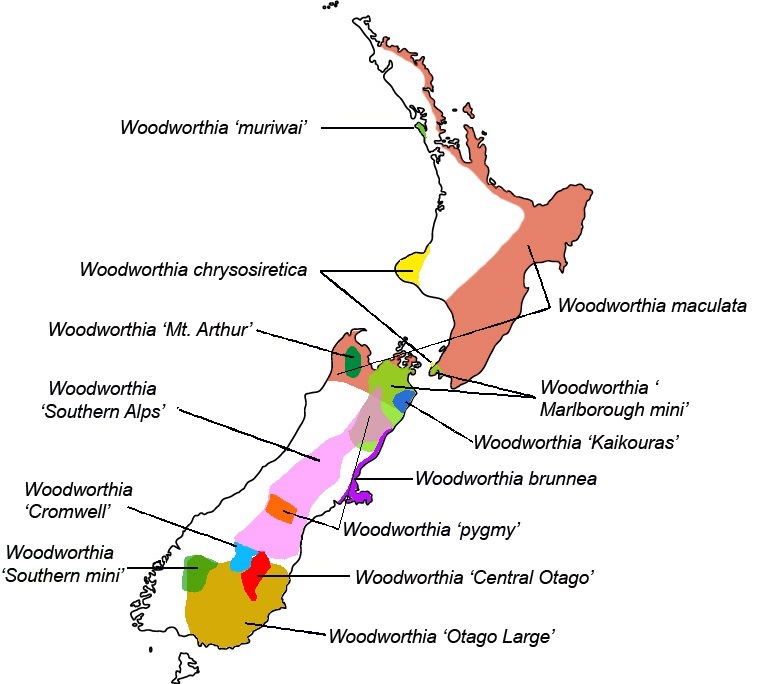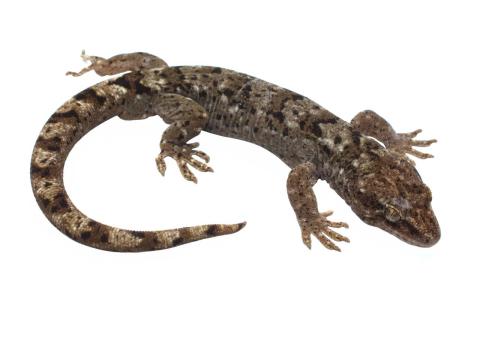Image attribution: Waitaha gecko (Woodworthia cf. brunnea). © Nick Harker
Woodworthia (the ‘rock or common geckos’) are small to medium-sized nocturnal geckos, which typically occur in rocky habitats (this is the main reason why the group is sometimes referred to as the 'rock geckos'). Although they are fairly distinct from other gecko genera in Aotearoa, they are on occasion confused with members of the Dactylocnemis (Pacific geckos), and Mokopirirakau (forest geckos) genera. However, on close inspection, they can easily be differentiated from these by their wide vs. narrow toes, and the level of contact between the rostral scales and the nostrils (not/barely touching vs. in broad contact).
In terms of their habitat preferences, most Woodworthia are terrestrial (as opposed to arboreal/tree climbing), and thus often inhabit coastal scrub/vineland, and various rocky habitats from the coastline through to the alpine zone (e.g., rocky coastlines, boulderfields, scree slopes, rock tors, and alpine bluffs).
The nature of some of these habitats means that refugia (shelters) can be hard to come across, resulting in the Woodworthia, in comparison to most of Aotearoa's herpetofauna, being fairly tolerant of conspecifics, often being observed in small to large aggregations (and occasionally with other gecko and skink species).

The following 'compare and contrast' table has been collated using information from Jewel (2008), and van Winkel (2018). At this stage, it does not include all of the currently known taxa from the Woodworthia genus, however, you can find the full list of these at the bottom of the page (below the reference section). By clicking on the species name (e.g., Woodworthia maculata) it will take you to the relevant species synopsis - a detailed description of the species, noting its life history, diet, habitat, and much more.
Description
Species
Colouration / description
Region / habitat
Mouth
Eyes
Feet
Size
Raukawa gecko (Woodworthia maculata)
The dorsal surface is largely grey or brown with irregular markings, including black, white, yellow/orange, and olive green patches. Markings are usually transverse, however, longitudinal markings can be found in some specimens or common in some populations. A canthal stripe may or may not be present.
North Island from the Bay of Islands to Wellington - coastal from the East cape northwards, does not occur on the west coast of the North Island above the Whanganui River.
Occurs in the northern South Island.
Generally coastal, but can occur further inland, particularly around rocky rivers.
Mouth lining pink, tongue pink with grey tip.
Brown, can be yellowish or greenish-brown.
Toes have 9-12 lamellae.
≤89mm SVL, usually smaller.
Waitaha gecko (Woodworthia cf. brunnea)
The dorsal surface is brown, though some individuals are grey or olive. Dorsal surface marked with bright chevron stripes, blotches, lateral or longitudinal bands. Large dark patches are common, particularly on the tail (if intact). The ventral surface is commonly pale and uniform in colour, with occasional individuals sporting a spotted belly.
South Island east coast, Banks Peninsula to southern Marlborough.
Duneland, low scrub and rock outcrops. Coastal and inland habitats.
The lower surfaces of the mouth and tongue are pink; the tongue tip is a diffuse grey.
Light to dark olive brown, pupils sometimes have a pale border.
Toes have 9-12 lamellae.
≤80mm SVL.
Minimac gecko (Woodworthia 'Marlborough mini')
Dorsal surfaces are drab brown, grey or olive-grey with pale blotches, bands or stripes. The Canthal stripe is straight and generally prominent.
North-east South Island, and Wellington's southwestern coastline.
Inhabits screes, rock outcrops, boulder beaches and scrubby vegetation. Coastal and inland habitats.
The lower surfaces of the mouth and tongue are pink
Brown
Toes have 9-12 lamellae.
≤65mm SVL.
Kahurangi gecko (Woodworthia 'Mount Arthur')
Grey to dark grey to olive-brown. Usually has a double row of paler blotches or single chevron-shaped bands.
Kahurangi National Park.
Inhabits screes, rock piles and creviced bluffs. Predominantly alpine.
Mouth lining pink, tongue pink- may have a grey tip.
Brown, may have olive mottling.
Toes have 11-12 lamellae.
≤70mm SVL.
Kaikouras gecko (Woodworthia 'Kaikoura')
Very similar to the minimac gecko (and in future may be placed within the minimac gecko species concept). Pale brown with pale blotches, bands or chevrons.
Inland sites of Eastern Marlborough to Kaikoura.
Inhabits screes, rock piles and scrubby vegetation.
Mouth: pink
Tongue: pink
Brown, may have olive mottling.
Toes have 10-12 lamellae.
≤65mm SVL.
Southern Alps gecko (Woodworthia 'Southern Alps') & Greywacke gecko (Woodworthia 'Southern Alps northern')
Generally grey and usually drab in appearance with paler bands or blotches (rarely stripes).
Inland sites from north Otago to southern Marlborough. Species are generally considered to occur on either side of the Rakaia River.
Inhabits screes, rock piles and scrubby vegetation. Very few records from beech and kānuka forests.
Mouth lining pink, tongue pink- may have a grey tip.
Greenish or brown. May have a bluish edge.
Toes have 9-12 lamellae.
≤72mm SVL.
Pygmy gecko (Woodworthia 'pygmy')
Very small gecko. Head short and deep.
The dorsal surface is light olive-grey, often with many paler blotches. Often two rows of blotches or bands.
Inland Marlborough, and northern Canterbury, including Kaikōura.
A southern population which may be distinct occurs in the Rangitata mountains.
Inhabits screes and rock piles, often in scrubby vegetation or grassland in lower alpine areas.
Mouth: pink
Tongue: pink
Brown with olive mottling.
Toes have 7-8 lamellae.
≤50mm SVL.
Kawarau gecko (Woodworthia 'Cromwell')
Grey, brown or olive with prominent pale blotches or bands. Occasionally may have stripes. The ventral surface is often heavily speckled.
Cromwell area.
Inhabits schist rock formations and associated scrubby vegetation.
Mouth: pink
Tongue: pink with a grey tip
Greenish brown to dark brown. May have greenish flecks.
Toes have 9-12 lamellae.
≤78mm SVL.
Schist gecko (Woodworthia 'Central Otago')
Brown / grey gecko with paler blotches, bands or stripes.
Mountain ranges and lowlands of central Otago.
Inhabits schist rock formations and associated scrubby vegetation.
Mouth lining pink, tongue pink with grey tip.
Brown to bright yellow
Toes have 9-11 lamellae.
≤71mm SVL.
Short-toed gecko (Woodworthia 'southern mini')
Light olive to olive-brown. Uniform colouration or with faint pale stripes. A relative of the Goldstripe gecko from the North Island.
Southern South Island.
Inhabits scree, boulder fields and rock crevices in subalpine and alpine areas.
Mouth lining pink, tongue pink with grey tip.
Brown
Toes have 10-13 lamellae.
≤65mm SVL.
Korero gecko (Woodworthia 'Otago large')
Variable colouration, from light olive grey to dark brown.
Inhabits forests, rocky grassland and rocky alpine areas.
Southland to North Otago
Mouth lining pink, tongue pink- may have a grey tip.
Brown, olive-brown
Toes have 8-12 lamellae.
≤95mm SVL.
Note: dorsal = upper surface; ventral = lower surface; SVL = snout to vent length
References
Jewell, T. (2008). A photographic guide to reptiles and amphibians of New Zealand. Auckland: New Holland.
van Winkel, D., Baling, M., Hitchmough, R. (2018). Reptiles and amphibians of New Zealand – a field guide. Auckland university press, Auckland New Zealand.


